|
   |
|
Page 5 |
Newsletter 120, Spring 2018 © Hampshire Mills Group |
|
A Pilgrimage to Macclesfield on the Silk Route
Sheila Viner
|
|
Oh little town of Macclesfield, how you called to me
time and again through the years ‘til at last I
came, saw, and was bowled over by the small pudding
hill clustered with a cacophony of diversely sized
Victorian and Edwardian buildings – shops, houses,
and small industrial places whose uses have been
surpassed; but because of its oddities it was
enchanting. Why were we here? Because Brian
Redhead told me about it, singing its praises
several times over, on Radio 4’s Today programme.
In fact, until then I’d never heard of Macclesfield.
That was in the 1980s and I knew I had to see it
for myself; and now as part of my current interest
in learning about textile mills and enquiring about
the Billinge Brothers from Macclesfield who built
the silk mill at Twyford, Berkshire, the time was
ripe for the visit.
After checking in to the Travelodge beside the
railway station and, needing to stretch our legs
after the lengthy drive from home, John and I set
out to explore our way to the Silk Museum as we were
only in Macclesfield overnight. Explore we did, as
there are no signs to the museum, and the various
locals we enquired of gave us different directions.
Having been up hill and down dale a few times, we
plodded down another slope to where the 21st century
bypass neatens the edges around the pudding and
found the 1879 School of Arts building which houses
the museum and the 1860s Paradise Silk Mill next to
it. |
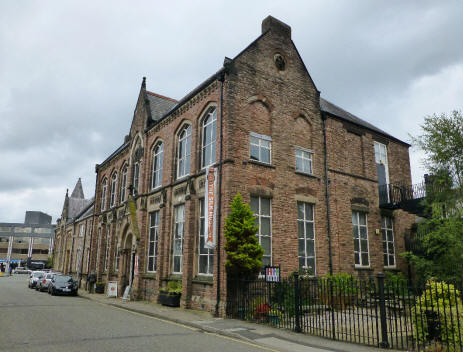 |
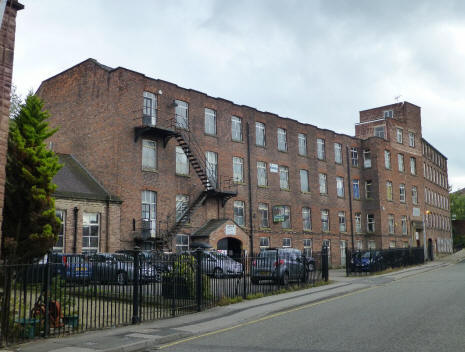 |
|
Machinery in the Silk Museum charts the mechanical
progress that helped to transform the 17th century
cottage industries of silk throwing and weaving,
said to be largely introduced to the area by
Huguenots, into factories of huge output of fine
quality silk products. A bold display, curling
around the walls, relates how silk is obtained from
silk moth cocoons and how very early industrial
spies (Marco Polo?) somehow purloined some heavily
guarded cocoons, rustled them out of China to Italy
and later France. After many decades the trade made
its way to England.
Macclesfield became a thriving centre for the silk
trade, with its proximity to the docks of Manchester
and Liverpool, coupled with ample labour and a
healthy supply of water power from the River Bollin.
Handmade silk buttons had long been a mainstay of
cottagers’ livelihoods under the direction of the
Mottershead family but the industry gained pace with
the introduction of progressive machinery; it was
expanded by the Brocklehurst family who later joined
forces with the Whiston Company to form BWA (Brocklehurst
Whiston Amalgamated), who went on to greater
successes with newly installed Jacquard machines.
|
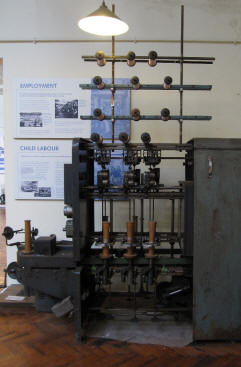 |
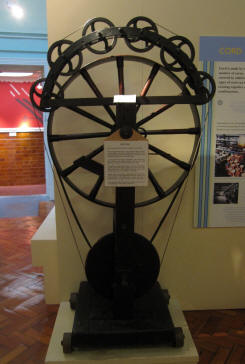 |
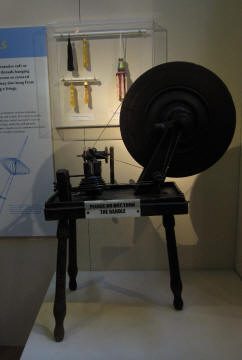 |
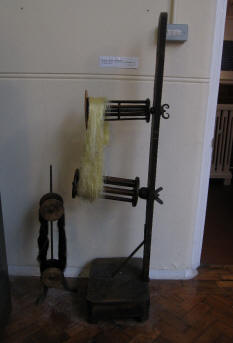 |
Above, left to right:
Spool winder, Cord twister, Tassel former
Left:
‘Rice’ – Wooden device with 2 shaking arms used to
prepare hanks of silk for transfer to skeins
Some
of the museum’s machines are worked for visitors,
but as we were there on a Monday, they were silent.
In fact, the whole place was quiet, due to no
guides or helpful written explanations of how the
machines worked. However, the sight of the massive
machines which could weave wall hanging ‘paintings’
in a multitude of coloured silk threads left me in
awe.
|
|
A bit more down-to-earth was the manufacture of
parachute silk during the war and a 1940s wedding
parachute dress was on display patterned with a
coloured Ordnance Survey map. The museum also holds
a very impressive collection, on display, of
Jacquard cards, plus a pattern book collection of
around 1000 volumes from local textile factories,
each with hundreds of examples of different woven
and printed designs and colourways. The pattern
books date from the mid-19th century through to the
1950s.
|
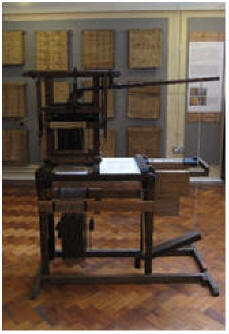
Jacquard machine
and cards |
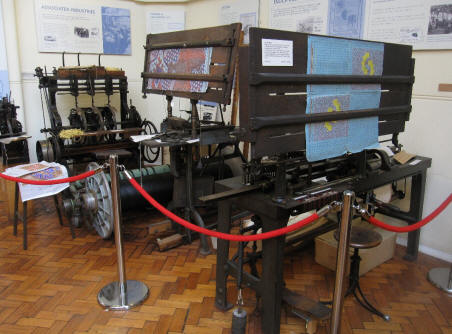
Picture weaving looms |

Wedding dress made from parachute silk |
|
Next to the Silk Museum stands Paradise Mill,
regularly operated weaving silk and open to visitors
(by guided tour only, pre-booking advised) but not,
sadly, open or weaving on our day. No one at the
museum knew anything of the Billinge Brothers of
Macclesfield either, but despite some
disappointments, I am very glad to have made it
there at last and do hope that one day I’ll return –
on another day of the week though! I certainly
commend it as worthwhile to see such a complete
story of the silk trade’s fascinating industrial
history, especially in context with our own
Whitchurch Silk Mill.
We are so lucky, though, to have the commercially
thriving Whitchurch Silk Mill on our doorsteps where
we can experience a variety of activities and
exhibitions – and probably have more chance of
seeing the wonderful machines in action.
The Silk Museum and Paradise Mill are at
Park Lane, Macclesfield SK11 6TJ.
For information, directions, opening times, and
admission charges visit
silkmacclesfield.org.uk
email
info@silkmacclesfield.org.uk
or
(
01625 612045.
|
|
|
